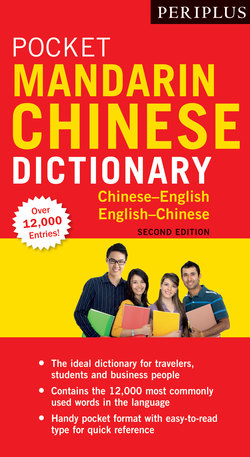Читать книгу Periplus Pocket Mandarin Chinese Dictionary - Philip Yungkin Lee - Страница 5
На сайте Литреса книга снята с продажи.
ОглавлениеIntroduction
This Pocket Dictionary is an indispensable companion for visitors to China and for anyone in the early stages of learning Chinese. It contains all the 12,000 or so Chinese words that are most commonly encountered in colloquial, everyday speech.
For the sake of clarity, only the common Chinese equivalents for each English word have been given. When an English word has more than one possible meaning, with different Chinese equivalents, each meaning is listed separately, with a clear explanatory gloss. The layout is clear and accessible, with none of the abbreviations and dense nests of entries typical of many small dictionaries.
The language represented in this dictionary is Modern Standard Chinese, which is also commonly known in English as Mandarin, and in China as Putonghua (literally “Modern Standard Chinese”) and Taiwan as Guoyu (literally “national speech”).
The People’s Republic of China has a population of over 1.35 billion people, more than 90% of whom are ethnically Chinese. They speak a large number of related languages, often collectively referred to as “Chinese dialects.” Many of these are mutually unintelligible in their spoken forms, although they are united by a common system of writing (see further below).
The main language groups are Mandarin, spoken in a broad area across the north and west of the country, Kan, Xiang, Wu, Northern Min, Southern Min, Hakka, and Cantonese. Most of these also contain within them a wide range of dialectal variation, especially as regards pronunciation and elements of vocabulary.
Modern Standard Chinese is based on the northern Mandarin dialects of the area surrounding the capital Beijing, and the standard pronunciation is that traditionally used in Beijing. Its use has been widely promoted as an instrument of national unity since the overthrow of the Manchu monarchy by the native Han Chinese in 1912, and especially since the founding of the PRC in 1949. Nowadays most people in China have a good knowledge of it even if they do not commonly speak it in daily life.
The written form of Chinese does not relate directly to the sounds of the language. Instead it makes use of a very large number of characters representing different syllables, to each of which is linked both a meaning and a sound. The meaning attached to each character is the same for each of the Chinese languages and dialects, although the way it is pronounced may well be different. In this way writing can serve as a means of communication between Chinese from geographically separated regions who would not be able to understand each other’s everyday speech.
The characters derived initially from the stylized representation of concrete objects, to which the abstract meanings needed for the expression of the whole language have been added by processes of combination and metaphor. The earliest written records of Chinese date back to the second millennium BCE, in the form of marks scratched on bones and shells used in a system of divination. The shapes of these characters are very different from the modern forms, but the development of the script from a directly representational system is already well advanced.
Classical Chinese literature dates from around 1500 BCE, and there has been some development of the characters over the succeeding centuries. Since the 1950s the government of the PRC has promoted the simplification of a number of characters that are complex in formation or contain a large number of strokes, and the reform has also been adopted in Singapore. All the Chinese words and phrases in this dictionary are written in these simplified characters. In Taiwan and Hong Kong the traditional forms of the characters are mostly still used, but the simplified forms are also readily understood.
In this dictionary every Chinese word and phrase is also given in the Roman alphabet, following the official system of transcription promulgated in 1958 and known as Hanyu Pinyin. A guide to the pronunciation of the romanized forms is given on the following pages.
Chinese is a tonal language, and it is extremely important to use the correct tone in pronouncing each syllable. In this dictionary the tones are indicated by diacritical marks over the vowels.
The words and phrases in the Chinese–English section of the dictionary are arranged in English alphabetical order using the letters and diacritical marks of the Hanyu Pinyin system of romanization. Words that have the same spelling but different tones are listed in order of their tones: first, second, third, fourth and neutral tone. For example, “ǎi 矮 short” comes before “ài 爱 to love.” Words that have the same spelling and the same tone are listed according to the complexity of the Chinese characters. For example, “gān 干 dry” with three strokes comes before “gān 肝 liver” with seven strokes.
Although the writing system and pronunciation of Chinese may be daunting for English speakers, grammatically it is not too problematic. There are no inflections as such (distinctions such as tense and number being indicated by various particles) and the word order is generally the same as in English.
